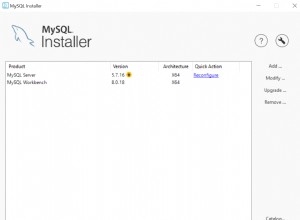Hier ist eine Abfrage, die Ihnen das und mehr liefert (siehe WHERE -Klausel für den gespeicherten Prozessnamen):
SELECT
[sJOB].[job_id] AS [JobID]
, [sJOB].[name] AS [JobName]
, [sJSTP].[step_uid] AS [StepID]
, [sJSTP].[step_id] AS [StepNo]
, [sJSTP].[step_name] AS [StepName]
, CASE [sJSTP].[subsystem]
WHEN 'ActiveScripting' THEN 'ActiveX Script'
WHEN 'CmdExec' THEN 'Operating system (CmdExec)'
WHEN 'PowerShell' THEN 'PowerShell'
WHEN 'Distribution' THEN 'Replication Distributor'
WHEN 'Merge' THEN 'Replication Merge'
WHEN 'QueueReader' THEN 'Replication Queue Reader'
WHEN 'Snapshot' THEN 'Replication Snapshot'
WHEN 'LogReader' THEN 'Replication Transaction-Log Reader'
WHEN 'ANALYSISCOMMAND' THEN 'SQL Server Analysis Services Command'
WHEN 'ANALYSISQUERY' THEN 'SQL Server Analysis Services Query'
WHEN 'SSIS' THEN 'SQL Server Integration Services Package'
WHEN 'TSQL' THEN 'Transact-SQL script (T-SQL)'
ELSE sJSTP.subsystem
END AS [StepType]
, [sPROX].[name] AS [RunAs]
, [sJSTP].[database_name] AS [Database]
, [sJSTP].[command] AS [ExecutableCommand]
, CASE [sJSTP].[on_success_action]
WHEN 1 THEN 'Quit the job reporting success'
WHEN 2 THEN 'Quit the job reporting failure'
WHEN 3 THEN 'Go to the next step'
WHEN 4 THEN 'Go to Step: '
+ QUOTENAME(CAST([sJSTP].[on_success_step_id] AS VARCHAR(3)))
+ ' '
+ [sOSSTP].[step_name]
END AS [OnSuccessAction]
, [sJSTP].[retry_attempts] AS [RetryAttempts]
, [sJSTP].[retry_interval] AS [RetryInterval (Minutes)]
, CASE [sJSTP].[on_fail_action]
WHEN 1 THEN 'Quit the job reporting success'
WHEN 2 THEN 'Quit the job reporting failure'
WHEN 3 THEN 'Go to the next step'
WHEN 4 THEN 'Go to Step: '
+ QUOTENAME(CAST([sJSTP].[on_fail_step_id] AS VARCHAR(3)))
+ ' '
+ [sOFSTP].[step_name]
END AS [OnFailureAction]
FROM
[msdb].[dbo].[sysjobsteps] AS [sJSTP]
INNER JOIN [msdb].[dbo].[sysjobs] AS [sJOB]
ON [sJSTP].[job_id] = [sJOB].[job_id]
LEFT JOIN [msdb].[dbo].[sysjobsteps] AS [sOSSTP]
ON [sJSTP].[job_id] = [sOSSTP].[job_id]
AND [sJSTP].[on_success_step_id] = [sOSSTP].[step_id]
LEFT JOIN [msdb].[dbo].[sysjobsteps] AS [sOFSTP]
ON [sJSTP].[job_id] = [sOFSTP].[job_id]
AND [sJSTP].[on_fail_step_id] = [sOFSTP].[step_id]
LEFT JOIN [msdb].[dbo].[sysproxies] AS [sPROX]
ON [sJSTP].[proxy_id] = [sPROX].[proxy_id]
WHERE [sJSTP].[command] LIKE '%MyStoredProc%'
ORDER BY [JobName], [StepNo]
Die Anerkennung sollte dem Artikel Querying SQL Server Agent gehen Stelleninformationen von Dattatrey Sindol für die meisten der obigen Abfragen.




